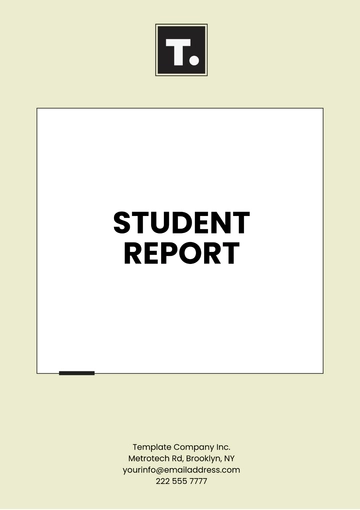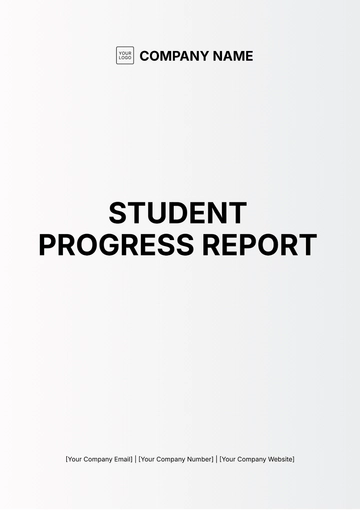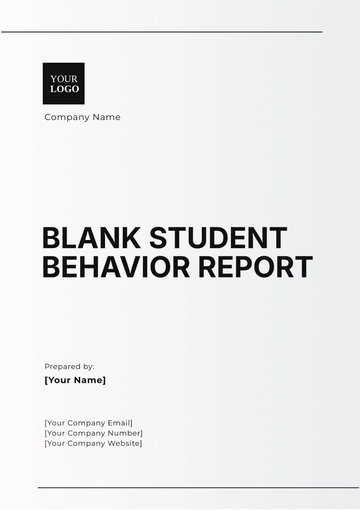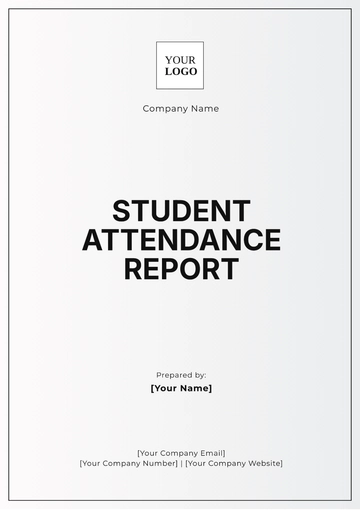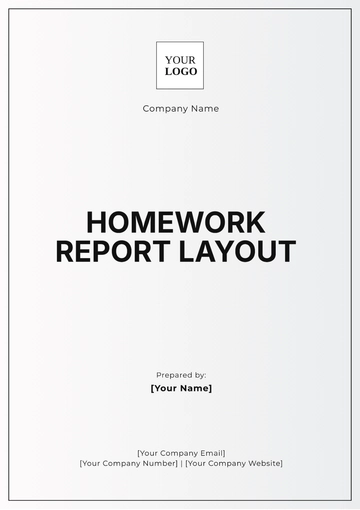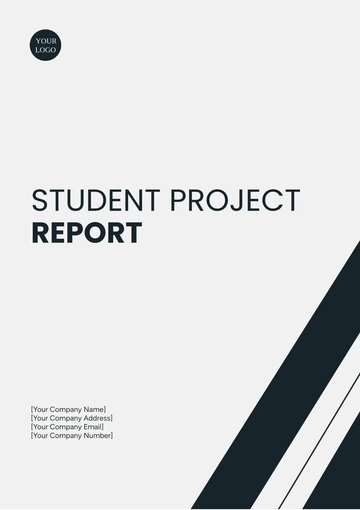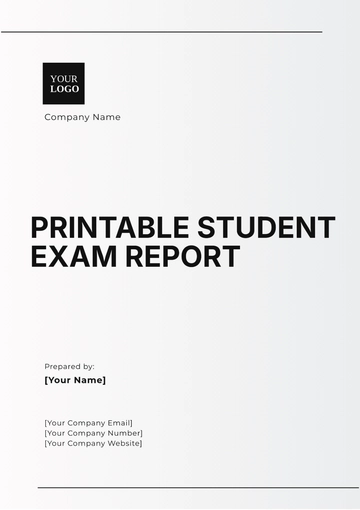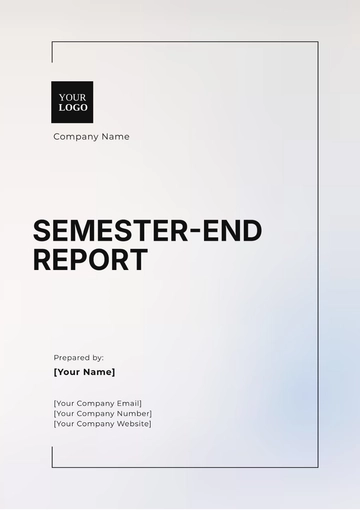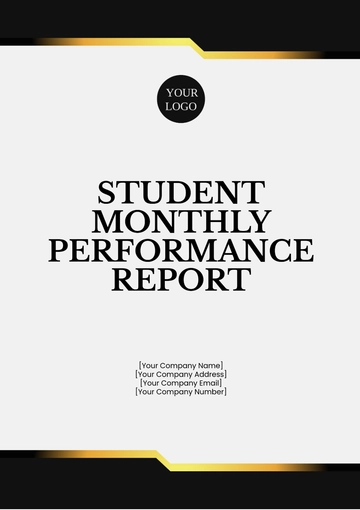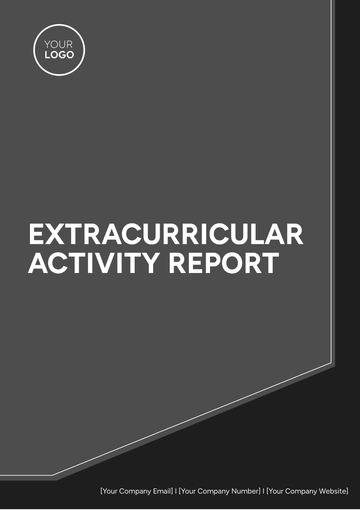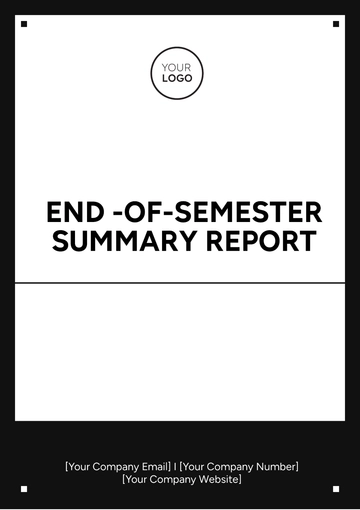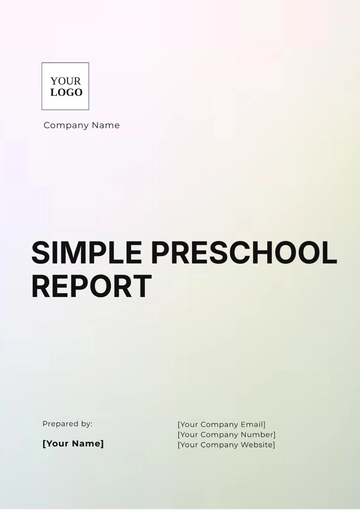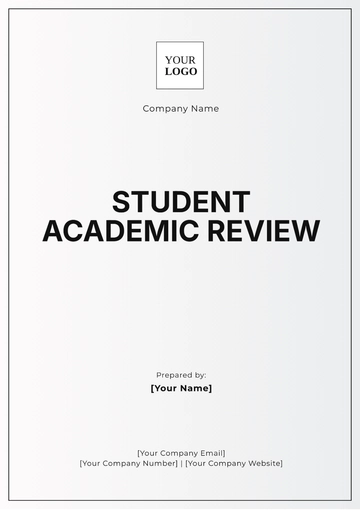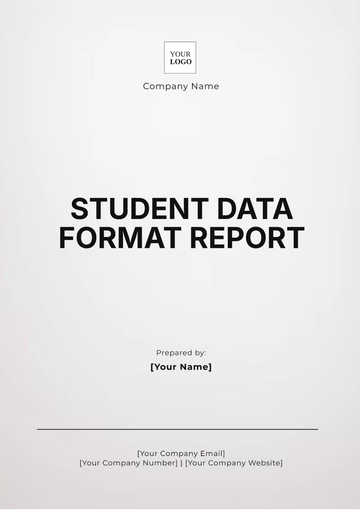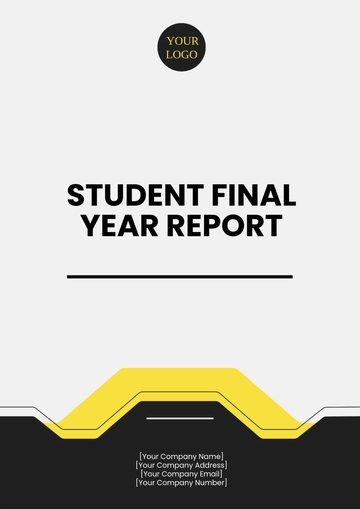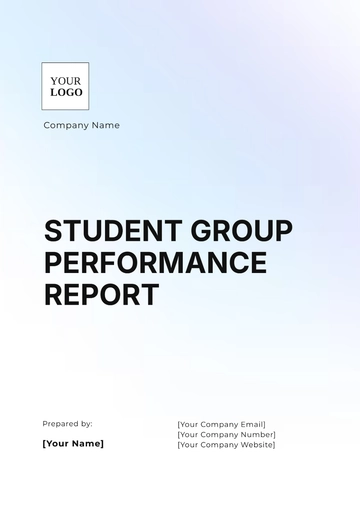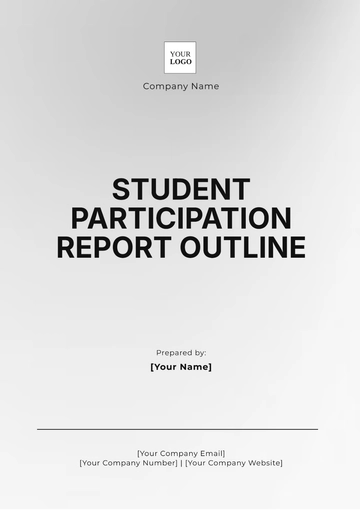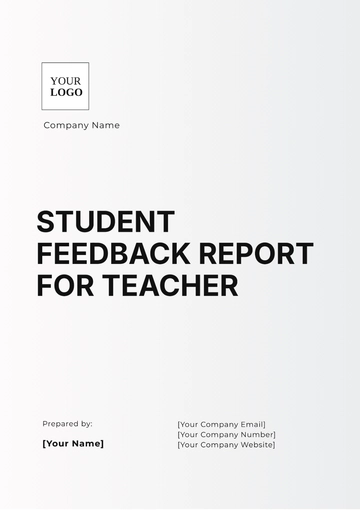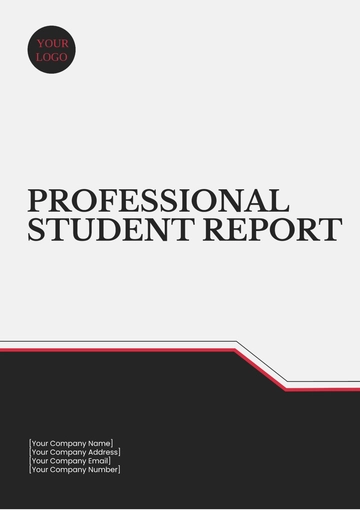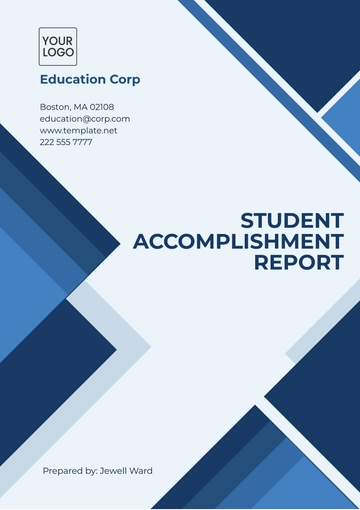Free Monthly Student Report
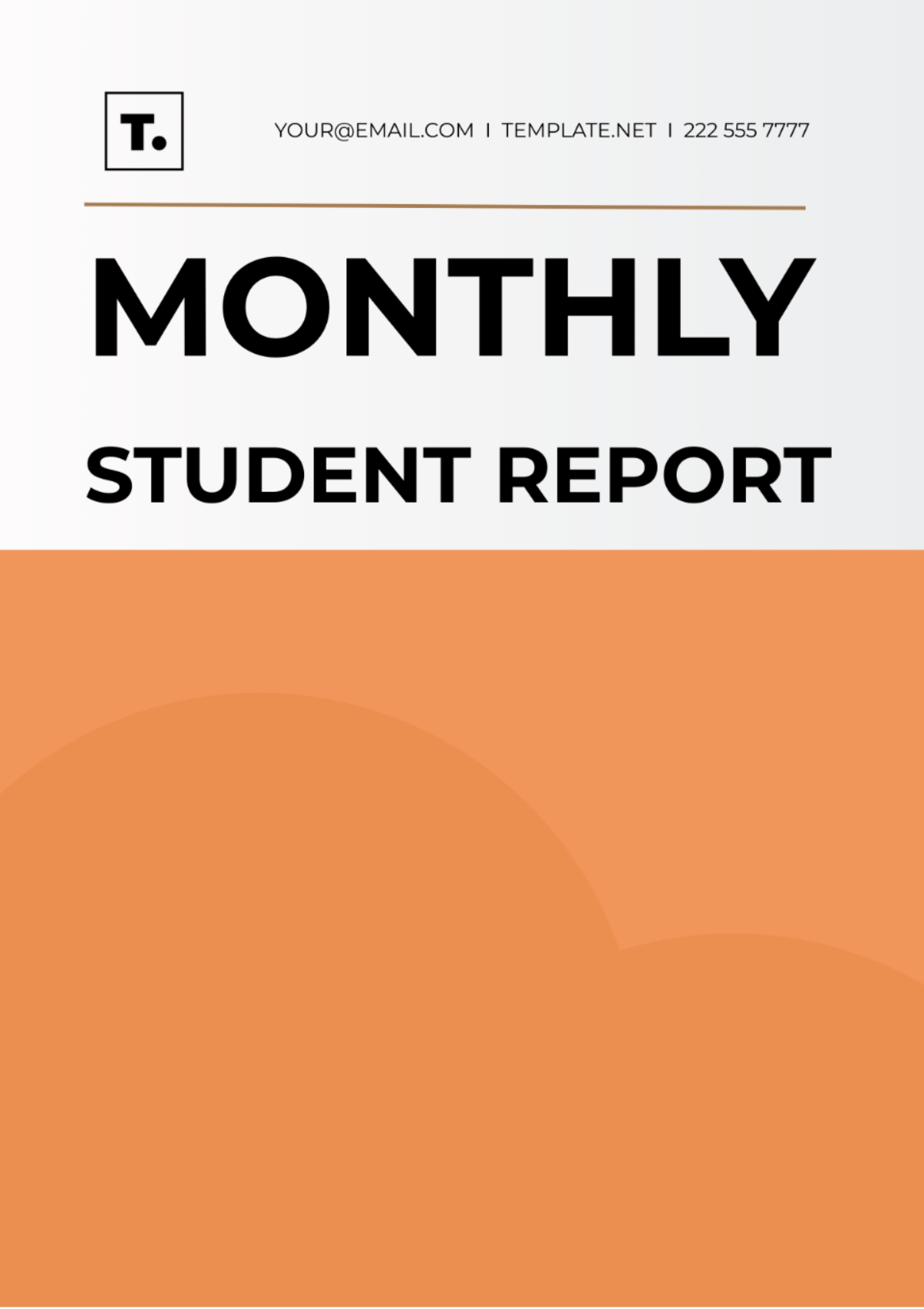
Prepared By | Company | Date Prepared |
|---|---|---|
[YOUR NAME] | [YOUR SCHOOL NAME] | [DATE] |
I. Introduction
The Monthly Student Report offers a detailed overview of [STUDENT'S NAME]'s academic performance, behavior, and progress during the month of [MONTH]. This report aims to provide [PARENTS] with insights into [STUDENT'S NAME]'s educational journey, highlighting achievements, areas for improvement, and recommendations for further development.
Objectives:
Provide insights into [STUDENT NAME]'s academic achievements and areas for improvement.
Highlight behavioral trends and classroom participation.
Offer recommendations for supporting [STUDENT NAME]'s continued growth and success.
II. Methodology
The data included in this report was gathered through a combination of methods aimed at providing a comprehensive understanding of [STUDENT'S NAME]'s academic performance and behavior. These methods include:
Classroom observations
Assessment results
Behavioral records
[ANY OTHER METHODS USED]
III. Findings
A. Academic Performance
[STUDENT'S NAME] demonstrated [STRENGTHS/WEAKNESSES] in the following subjects:
Mathematics: [DETAILED FINDINGS]
Language Arts: [DETAILED FINDINGS]
Science: [DETAILED FINDINGS]
Social Studies: [DETAILED FINDINGS]
B. Behavioral Observations
[STUDENT'S NAME]'s behavior was noted to be [POSITIVE/NEGATIVE] in the following areas:
Classroom Conduct: [DETAILED OBSERVATIONS]
Interactions with Peers: [DETAILED OBSERVATIONS]
Responsibility and Accountability: [DETAILED OBSERVATIONS]
IV. Analysis
[STUDENT'S NAME]'s academic performance and behavior were thoroughly analyzed in relation to the standards and expectations set by [YOUR SCHOOL NAME]. Various factors contributing to [STUDENT'S NAME]'s performance were carefully examined to gain a comprehensive understanding of their progress and areas for improvement.
Academic Performance: [STUDENT'S NAME]'s performance in academic subjects was evaluated based on factors such as comprehension of the curriculum, mastery of key concepts, and ability to apply learned knowledge. Assessment results, classroom observations, and other data were analyzed to assess [STUDENT'S NAME]'s academic strengths and weaknesses.
Behavioral Patterns: [STUDENT'S NAME]'s behavior and conduct within the classroom and school environment were closely scrutinized. Factors such as attendance, participation in class activities, adherence to rules and regulations, and interactions with peers and teachers were assessed to identify patterns and trends in [STUDENT'S NAME]'s behavior.
External Factors: In addition to academic and behavioral factors, external influences such as family dynamics, personal circumstances, and socio-economic background were taken into consideration during the analysis. These external factors may impact [STUDENT'S NAME]'s academic performance and behavior and were examined to provide context for their overall progress.
By conducting a thorough analysis of [STUDENT'S NAME]'s academic performance and behavior, this report aims to identify underlying factors contributing to their success or challenges and inform the development of targeted strategies and interventions to support their continued growth and development.
V. Academic Achievements
[STUDENT'S NAME]'s notable academic achievements during the month include:
Achievement | Brief Description |
|---|---|
[ACHIEVEMENT 1] | [DESCRIPTION OF ACHIEVEMENT 1] |
[ACHIEVEMENT 2] | [DESCRIPTION OF ACHIEVEMENT 2] |
[ACHIEVEMENT 3] | [DESCRIPTION OF ACHIEVEMENT 3] |
[ACHIEVEMENT 4] | [DESCRIPTION OF ACHIEVEMENT 4] |
[ACHIEVEMENT 5] | [DESCRIPTION OF ACHIEVEMENT 5] |
VI. Goals for Next Month
Based on the findings and analysis, the following goals have been established for [STUDENT'S NAME] for the next month:
Academic Goals:
[ACADEMIC GOAL 1]: [DESCRIPTION OF ACADEMIC GOAL 1]
[ACADEMIC GOAL 2]: [DESCRIPTION OF ACADEMIC GOAL 2]
[ACADEMIC GOAL 3]: [DESCRIPTION OF ACADEMIC GOAL 3]
These academic goals are designed to address areas of improvement and further enhance [STUDENT'S NAME]'s academic performance. They focus on specific subjects or skills that [STUDENT'S NAME] should strive to improve or master during the next month.
Behavioral Goals:
[BEHAVIORAL GOAL 1]: [DESCRIPTION OF BEHAVIORAL GOAL 1]
[BEHAVIORAL GOAL 2]: [DESCRIPTION OF BEHAVIORAL GOAL 2]
[BEHAVIORAL GOAL 3]: [DESCRIPTION OF BEHAVIORAL GOAL 3]
These behavioral goals aim to promote positive behavior and social skills while addressing any areas of concern identified during the analysis. They encourage [STUDENT'S NAME] to demonstrate appropriate conduct, communication, and interaction within the classroom and school environment.
VII. Recommendations
To support [STUDENT'S NAME]'s academic and behavioral development, the following recommendations are proposed:
Parental Involvement:
Regular Communication: Encourage parents to maintain regular communication with teachers to stay informed about [STUDENT'S NAME]'s progress and any areas needing improvement.
Home Learning Environment: Provide suggestions for creating a conducive learning environment at home, including designated study areas and establishing routines for homework and study sessions.
Encouragement and Support: Advocate for parents to actively engage in [STUDENT'S NAME]'s academic journey by providing encouragement, praise for achievements, and support during challenging times.
Teacher Support:
Individualized Instruction: Collaborate with teachers to develop individualized learning plans tailored to [STUDENT'S NAME]'s academic needs and learning style.
Differentiated Instruction: Encourage teachers to employ differentiated teaching strategies to accommodate [STUDENT'S NAME]'s diverse learning needs and abilities.
Regular Progress Monitoring: Recommend regular progress monitoring and assessment to track [STUDENT'S NAME]'s academic and behavioral progress, allowing for timely interventions and adjustments as needed.
Student Strategies:
Goal Setting: Encourage [STUDENT'S NAME] to set specific, achievable academic and behavioral goals for themselves, with guidance and support from teachers and parents.
Time Management: Provide strategies for effective time management and organization to help [STUDENT'S NAME] balance academic responsibilities and extracurricular activities.
Study Skills: Offer guidance on developing effective study skills, such as note-taking techniques, active reading strategies, and test preparation methods, to enhance [STUDENT'S NAME]'s academic performance.
By implementing these recommendations, we can create a supportive learning environment that fosters [STUDENT'S NAME]'s academic and behavioral growth, empowering them to reach their full potential.
VIII. Conclusion
In conclusion, the Monthly Student Report offers valuable insights into [STUDENT'S NAME]'s academic performance and behavior. By identifying achievements, areas for improvement, and setting goals for the next month, we aim to support [STUDENT'S NAME]'s continued growth and success in [SCHOOL]. This report serves as a roadmap for collaboration between parents, teachers, and administrators to provide the necessary support and resources for [STUDENT'S NAME]'s development. With a concerted effort and commitment to excellence, we are confident that [STUDENT'S NAME] will thrive academically and socially, contributing positively to the school community.
- 100% Customizable, free editor
- Access 1 Million+ Templates, photo’s & graphics
- Download or share as a template
- Click and replace photos, graphics, text, backgrounds
- Resize, crop, AI write & more
- Access advanced editor
Discover the ultimate tool for academic success with Template.net's Monthly Student Report Template. This editable and customizable template empowers students to showcase their progress effortlessly. Crafted with precision and editable in our Ai Editor Tool, it's the ideal companion for tracking achievements and setting goals. Upgrade your academic journey today!
You may also like
- Sales Report
- Daily Report
- Project Report
- Business Report
- Weekly Report
- Incident Report
- Annual Report
- Report Layout
- Report Design
- Progress Report
- Marketing Report
- Company Report
- Monthly Report
- Audit Report
- Status Report
- School Report
- Reports Hr
- Management Report
- Project Status Report
- Handover Report
- Health And Safety Report
- Restaurant Report
- Construction Report
- Research Report
- Evaluation Report
- Investigation Report
- Employee Report
- Advertising Report
- Weekly Status Report
- Project Management Report
- Finance Report
- Service Report
- Technical Report
- Meeting Report
- Quarterly Report
- Inspection Report
- Medical Report
- Test Report
- Summary Report
- Inventory Report
- Valuation Report
- Operations Report
- Payroll Report
- Training Report
- Job Report
- Case Report
- Performance Report
- Board Report
- Internal Audit Report
- Student Report
- Monthly Management Report
- Small Business Report
- Accident Report
- Call Center Report
- Activity Report
- IT and Software Report
- Internship Report
- Visit Report
- Product Report
- Book Report
- Property Report
- Recruitment Report
- University Report
- Event Report
- SEO Report
- Conference Report
- Narrative Report
- Nursing Home Report
- Preschool Report
- Call Report
- Customer Report
- Employee Incident Report
- Accomplishment Report
- Social Media Report
- Work From Home Report
- Security Report
- Damage Report
- Quality Report
- Internal Report
- Nurse Report
- Real Estate Report
- Hotel Report
- Equipment Report
- Credit Report
- Field Report
- Non Profit Report
- Maintenance Report
- News Report
- Survey Report
- Executive Report
- Law Firm Report
- Advertising Agency Report
- Interior Design Report
- Travel Agency Report
- Stock Report
- Salon Report
- Bug Report
- Workplace Report
- Action Report
- Investor Report
- Cleaning Services Report
- Consulting Report
- Freelancer Report
- Site Visit Report
- Trip Report
- Classroom Observation Report
- Vehicle Report
- Final Report
- Software Report
